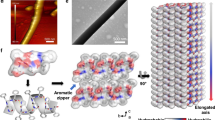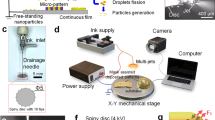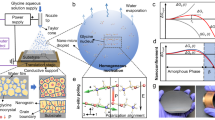Abstract
Piezoelectric materials can convert mechanical energy into electrical energy1,2, and piezoelectric devices made of a variety of inorganic materials3,4,5 and organic polymers6 have been demonstrated. However, synthesizing such materials often requires toxic starting compounds, harsh conditions and/or complex procedures7. Previously, it was shown that hierarchically organized natural materials such as bones8, collagen fibrils9,10 and peptide nanotubes11,12 can display piezoelectric properties. Here, we demonstrate that the piezoelectric and liquid-crystalline properties of M13 bacteriophage (phage) can be used to generate electrical energy. Using piezoresponse force microscopy, we characterize the structure-dependent piezoelectric properties of the phage at the molecular level. We then show that self-assembled thin films of phage can exhibit piezoelectric strengths of up to 7.8 pm V−1. We also demonstrate that it is possible to modulate the dipole strength of the phage, hence tuning the piezoelectric response, by genetically engineering the major coat proteins of the phage. Finally, we develop a phage-based piezoelectric generator that produces up to 6 nA of current and 400 mV of potential and use it to operate a liquid-crystal display. Because biotechnology techniques enable large-scale production of genetically modified phages, phage-based piezoelectric materials potentially offer a simple and environmentally friendly approach to piezoelectric energy generation.
This is a preview of subscription content, access via your institution
Access options
Subscribe to this journal
Receive 12 print issues and online access
$259.00 per year
only $21.58 per issue
Buy this article
- Purchase on SpringerLink
- Instant access to full article PDF
Prices may be subject to local taxes which are calculated during checkout




Similar content being viewed by others
References
Damjanovic, D. Ferroelectric, dielectric and piezoelectric properties of ferroelectric thin films and ceramics. Rep. Prog. Phys. 61, 1267–1324 (1998).
Galhardi, M. A., Guilherme, T. H. & Junior, V. L. A review of power harvesting on mechanical vibration using piezoelectric materials and applications, in Proc. 7th Brazilian Conference on Dynamics, Control and Applications 1005–1013 (Universidade Estadual Paulista (UNESP), 2008).
Chen, X., Xu, S. Y., Yao, N. & Shi, Y. 1.6 V nanogenerator for mechanical energy harvesting using PZT nanofibers. Nano Lett. 10, 2133–2137 (2010).
Hu, Y., Lin, L., Zhang, Y. & Wang, Z. L. Replacing a battery by a nanogenerator with 20 V output. Adv. Mater. 24, 110–114 (2012).
Wang, Z. L. & Song, J. Piezoelectric nanogenerators based on zinc oxide nanowire arrays. Science 312, 242–246 (2006).
Chang, C., Tran, V. H., Wang, J., Fuh, Y-K. & Lin, L. Direct-write piezoelectric polymeric nanogenerator with high energy conversion efficiency. Nano Lett. 10, 726–731 (2010).
Saito, Y. et al. Lead-free piezoceramics. Nature 432, 84–87 (2004).
Bassett, C. A. L. & Becker, R. O. Generation of electric potentials by bone in response to mechanical stress. Science 137, 1063–1064 (1962).
Fukada, E. Piezoelectric properties of biological polymers. Q. Rev. Biophys. 16, 59–87 (1983).
Minary-Jolandan, M. & Yu, M-F. Nanomechanical heterogeneity in the gap and overlap regions of type I collagen fibrils with implications for bone heterogeneity. Biomacromolecules 10, 2565–2570 (2009).
Farrar, D. et al. Permanent polarity and piezoelectricity of electrospun α-helical poly(α-amino acid) fibers. Adv. Mater. 23, 3954–3958 (2011).
Kholkin, A., Amdursky, N., Bdikin, I., Gazit, E. & Rosenman, G. Strong piezoelectricity in bioinspired peptide nanotubes. ACS Nano 4, 610–614 (2010).
Lee, S-W., Mao, C., Flynn, C. E. & Belcher, A. M. Ordering of quantum dots using genetically engineered viruses. Science 296, 892–895 (2002).
Douglas, T. & Young, M. Host–guest encapsulation of materials by assembled virus protein cages. Nature 393, 152–155 (1998).
Naik, R. R., Stringer, S. J., Agarwal, G., Jones, S. E. & Stone, M. O. Biomimetic synthesis and patterning of silver nanoparticles. Nature Mater. 1, 169–172 (2002).
Lee, Y. J. et al. Fabricating genetically engineered high-power lithium-ion batteries using multiple virus genes. Science 324, 1051–1055 (2009).
Nam, Y. S. et al. Biologically templated photocatalytic nanostructures for sustained light-driven water oxidation. Nature Nanotech. 5, 340–344 (2010).
Merzlyak, A., Indrakanti, S. & Lee, S. W. Genetically engineered nanofiber-like viruses for tissue regenerating materials. Nano Lett. 9, 846–852 (2009).
Rong, J. et al. Oriented cell growth on self-assembled bacteriophage M13 thin films. Chem. Commun. 5185–5187 (2008).
Smith, G. P. & Petrenko, V. A. Phage display. Chem. Rev. 97, 391–410 (1997).
Dogic, Z. & Fraden, S. Smectic phase in a colloidal suspension of semiflexible virus particles. Phys. Rev. Lett. 78, 2417–2420 (1997).
Kalinin, S. V. & Bonnell, D. A. Imaging mechanism of piezoresponse force microscopy of ferroelectric surfaces. Phys. Rev. B 65, 125408 (2002).
Chung, W-J. et al. Biomimetic self-templating supramolecular structures. Nature 478, 364–368 (2011).
Bhattacharjee, S., Glucksman, M. J. & Makowski, L. Structural polymorphism correlated to surface charge in filamentous bacteriophages. Biophys. J. 61, 725–735 (1992).
Marvin, D. A., Welsh, L. C., Symmons, M. F., Scott, W. R. P. & Straus, S. K. Molecular structure of fd (f1, M13) filamentous bacteriophage refined with respect to X-ray fibre diffraction and solid-state NMR data supports specific models of phage assembly at the bacterial membrane. J. Mol. Biol. 355, 294–309 (2006).
Yoo, S. Y., Chung, W-J., Kim, T. H., Le, M. & Lee, S-W. Facile patterning of genetically engineered M13 bacteriophage for directional growth of human fibroblast cells. Soft Matter 7, 363–368 (2011).
Kim, D. M. et al. Thickness dependence of structural and piezoelectric properties of epitaxial Pb(Zr0.52Ti0.48)O3 films on Si and SrTiO3 substrates. Appl. Phys. Lett. 88, 142904 (2006).
Durkan, C., Welland, M. E., Chu, D. P. & Migliorato, P. Probing domains at the nanometer scale in piezoelectric thin films. Phys. Rev. B 60, 16198–16204 (1999).
Jungk, T., Hoffmann, A. & Soergel, E. Contrast mechanisms for the detection of ferroelectric domains with scanning force microscopy. New J. Phys. 11, 033029 (2009).
Minary-Jolandan, M. & Yu, M. F. Nanoscale characterization of isolated individual type I collagen fibrils: polarization and piezoelectricity. Nanotechnology 20, 085706 (2009).
Newman, B. A., Kim, K. G. & Scheinbeim, J. I. Effect of water content on the piezoelectric properties of nylon 11 and nylon 7. J. Mater. Sci. 25, 1779–1783 (1990).
Wan, Y., Xie, L., Zhang, X. & Zhong, Z. Time dependence of piezoelectric d33 coefficient of cellular ferroelectret polypropylene film. Appl. Phys. Lett. 98, 122902 (2011).
Elmessiery, M. A. Physical basis for piezoelectricity of bone-matrix. IEE Proc. A 128, 336–346 (1981).
Acknowledgements
The authors thank Jiyoung Chang and Liwei Lin (University of California, Berkeley) for help with device fabrication and signal measurement. This work was supported by the National Science Foundation Center of Integrated Nanomechanical Systems (EEC-0832819) and the Laboratory Directed Research and Development fund from the Lawrence Berkeley National Laboratory.
Author information
Authors and Affiliations
Contributions
B.Y.L. and S.W.L. conceived the experiment. B.Y.L., J.Z., C.Z. and J.M. performed PFM experiments. W.C., J.M. and C.Z. prepared the phage monolayer and multilayer films. Y.S.Y. prepared the genetically engineered phages. B.Y.L. fabricated the energy-generating devices and carried out measurement of the signals. B.Y.L. and E.W. performed the nanoindentation experiments on phage films. E.W. modelled the electrostatic potential of phage coat proteins. B.Y.L., J.Z., J.M., R.R. and S.W.L. analysed the data. B.Y.L., C.Z., E.W. and S.W.L. wrote the manuscript.
Corresponding author
Ethics declarations
Competing interests
The authors declare no competing financial interests.
Supplementary information
Supplementary information
Supplementary information (PDF 1411 kb)
Supplementary information
Supplementary movie (MOV 9071 kb)
Supplementary information
Supplementary movie (MOV 4195 kb)
Rights and permissions
About this article
Cite this article
Lee, B., Zhang, J., Zueger, C. et al. Virus-based piezoelectric energy generation. Nature Nanotech 7, 351–356 (2012). https://doi.org/10.1038/nnano.2012.69
Received:
Accepted:
Published:
Issue Date:
DOI: https://doi.org/10.1038/nnano.2012.69
This article is cited by
-
Self-powered and self-sensing devices based on piezoelectric energy harvesting
Science China Technological Sciences (2024)
-
Biomimetic natural biomaterials for tissue engineering and regenerative medicine: new biosynthesis methods, recent advances, and emerging applications
Military Medical Research (2023)
-
Monomeric streptavidin phage display allows efficient immobilization of bacteriophages on magnetic particles for the capture, separation, and detection of bacteria
Scientific Reports (2023)
-
Active self-assembly of piezoelectric biomolecular films via synergistic nanoconfinement and in-situ poling
Nature Communications (2023)
-
Advances in wearable flexible piezoelectric energy harvesters: materials, structures, and fabrication
Journal of Materials Science: Materials in Electronics (2023)



